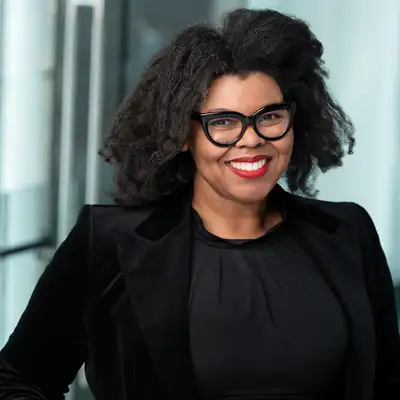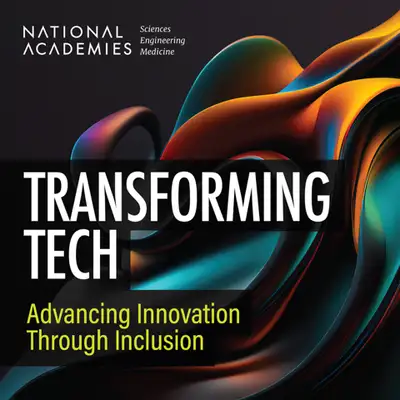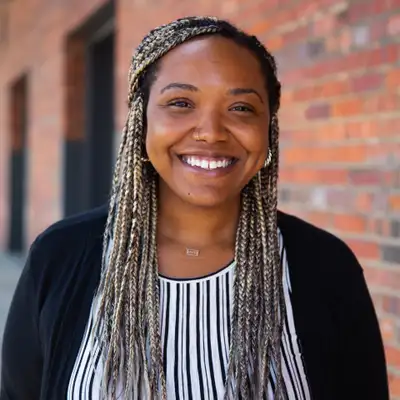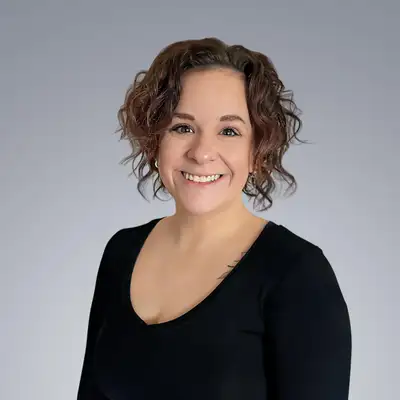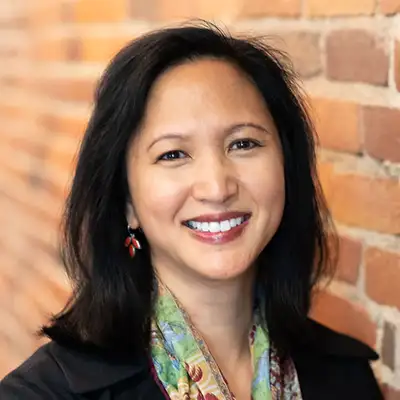Creators and Guests
What is Transforming Tech: Advancing Innovation Through Inclusion?
You work at a tech company, and you want to do the right thing: You want to hire people from all backgrounds, and you want to make sure your workplace is inclusive. But where do you start? What do you do?
Join entrepreneur, computer scientist, and CEO Jamika Burge in this five-part series from the National Academies of Sciences. Based on research and analysis from the National Academies consensus study “Transforming Trajectories for Women of Color in Tech”, Burge and her guests use design thinking to help engineering and tech companies recruit, retain, and advance women and people of color in their ranks.
Each episode will give you actionable solutions to increase diverse people and perspectives. Inclusion isn’t impossible. Let’s transform tech.
Jamika Burge (00:00):
The tech sector has a diversity problem. In the tech workforce, 69% of employees are white, and 64% are men, higher percentages than in the corporate world in general. In tech leadership, it's worse. 83% of the C-suite is white, and 80% is male. While 16% of employees in Silicon Valley are white women, only 3% are women of color.
Jamika Burge (00:36):
Of course, we all want to do the right thing and make our companies more representative. Diversity in the workplace is also good for business. Research shows that more diverse teams are not only more productive, they produce more creative solutions. So how do you find and hire diverse and qualified people, particularly women of color, into the tech space? And once they arrive, how do you retain them in your company and help them advance to the next level in their careers?
Jamika Burge (01:08):
You can start by listening to this. Welcome to Transforming Tech.
Jamika Burge (01:17):
My name is Jamika Burge. I'm an entrepreneur, a computer science PhD, a design researcher and the CEO and Co-Founder of BlackComputer.org, a tech nonprofit dedicated to supporting computing and tech education and workforce development for Black women and girls.
Jamika Burge (01:36):
As part of my work, I was able to participate in a project with the National Academies of Sciences, Engineering, and Medicine that brought together people from across the technology ecosystem, all of them devoted to helping women of color succeed in the tech sector. We studied the barriers that women of color face in tech from their undergraduate careers to the doors of the C-suite. The result was a large consensus study called "Transforming Trajectories for Women of Color in Tech," which uses the most current research and the results of workshops to provide the best recommendations for diversifying the tech workforce.
Jamika Burge (02:14):
The recommendations in the report are not just about the importance of diversity. We know that the talent and drive of brilliant women of color will be essential to building and maintaining a competitive workforce that will drive the tech sector into the future. The report then identified where exactly women of color leave the technical path and how we can fix the system to make sure that everyone has the skills to succeed.
Jamika Burge (02:42):
The report is available for free download on the National Academies website, and we will of course provide a link to it in our show notes, but we realized very quickly that a formal, very long, and slightly dry report just wasn't going to be enough to help companies achieve their diversity goals. We wanted to get the word out to share the actions that companies can take right now to increase the diversity of their workforce.
Jamika Burge (03:07):
In this five-part show, we will use design thinking, a creative, human-centered, problem-solving process that unlocks innovation at the intersection of business by amplifying competitive advantage on the one hand and technology on the other to ideate solutions to the wicked problem of bias. As a tech and design practitioner, I've used design thinking and taught it as a framework to help investigate the problem space, deeply understand human experience, and develop prototypes. Now, I want to use this framework to design a better world for women of color in tech.
Jamika Burge (03:45):
I'll walk you through understanding the depth and breadth of the diversity problem, reveal the barriers that women of color face when breaking into and advancing in the tech workforce, then brainstorm ideas for solutions while examining the data that shows whether or not those solutions work.
Jamika Burge (04:04):
It turns out that the lack of diversity in tech isn't an insurmountable problem with solutions that are vague or out of reach. This podcast will offer you a quick, digestible, and most of all, actionable guide to recruiting diverse people, retaining those hires, and seeing them advance. On the way, I'll talk with experts in the research and corporate worlds to understand the problems and offer real solutions that companies and managers can implement to achieve true diversity, equity, and inclusion.
Jamika Burge (04:38):
In the first episode, we're starting with recruitment. We know that finding good candidates for tech jobs is not simple. Often, companies need someone quickly who is well-qualified, who can be trained easily, and who doesn't require a lot of budget to find. Unfortunately, taking the easiest path through recruitment can mean that your company recruits people who are the easiest to find and who are not necessarily diverse. Even when a company does invite diverse applicants, often they don't make it to the final round.
Jamika Burge (05:10):
In this episode, we'll speak with computer science professor, Ann Quiroz Gates, Google Program Manager for University Relations, Sloan Davis, and Joan Williams, the founder of Bias Interrupters, to explore where diversity problems in recruitment come from, what recruitment could and should look like, and the new connections and efforts companies can make to solve them.
Jamika Burge (05:37):
We need more workers in STEM professions. In a 2011 report from the President's Council of Advisors on Science Technology, experts concluded that we need 1 million more STEM professionals by 2030. Not only that, a 2016 report from the Intel Corporation and Dalbury Global Development Advisors showed that increasing racial and ethnic diversity could add $470 to $570 billion in new value to the US tech industry. That's billion with a B.
Jamika Burge (06:14):
When we talk about employees in computing and tech, it can help to think about a road. This helps us envision a nice, clear track where someone can move swiftly from their student days where they learn to love to code, speed through college where they pick up research and experience, and establish their professional networks, and then this nice smooth road deposits them neatly into a job where they feel they can learn and grow and contribute. It's a beautiful view, but the reality is that the road isn't a straight, well-paved highway. Especially for women of color in tech, the road is narrow and filled with potholes and nails that will shred our tires and make us seek employment elsewhere.
Jamika Burge (07:05):
Women of color account for 39% of women in the United States. They will be the majority of women in the country by 2060, but in computing, women of color earn less than 10% of the bachelor's degrees and less than 5% of doctorate degrees. Once they get into the workforce, women of color make up only 3% of employees. Women of color are a talent pool that is being left untapped, one with huge potential.
Jamika Burge (07:39):
The road to tech is full of potholes, and one of the biggest is in recruitment. Women of color submit fewer job applications for tech jobs compared to other groups, which means that even fewer women of color get hired for tech roles.
Sloan Davis (07:57):
If we have, let's say, 87% of our applicants identify with at least one historically marginalized gender, race, ethnicity, or ability identity, but only 62% of our accepted users identify with one of those groups, something happened in our review process.
Jamika Burge (08:21):
That's Sloan Davis. At Google, Sloan works towards equity in computing research and education by designing and studying interventions that meet the needs of students and educators from historically marginalized groups.
Jamika Burge (08:34):
We're going to hear more from Sloan later, but as she notes, in the process between application and the final hire, diversity often ends up getting tossed aside and discarded, even though companies and hiring managers really do want to hire candidates from traditionally marginalized groups. Where does it fall through?
Jamika Burge (08:54):
For that, I spoke with Joan Williams, the Sullivan Professor of Law and Founding Director of the Center for WorkLife Law at the University of California Hastings Law. She's also the Founder of Bias Interrupters, a data-driven approach to identifying and combating bias in the workplace. She's a rock star in the world of workplace bias, and I was so thrilled to speak with her about where the bias comes in as companies recruit new hires. Bias can come in at any point in the recruiting process. Of course, everyone's process is different, but Williams identifies five key points.
Joan Williams (09:34):
Well, there's really several different parts to recruiting. One is establishing the original pool. The next is who survives resume review. The third is who gets interviews and who survives them. And the fourth is who gets offers and who takes them. And actually, there's some research that shows that the fifth important point is starting salaries because often white men are offered higher starting salaries than any other group.
Jamika Burge (10:07):
Bias can creep in at any point. Take that original pool, for example.
Joan Williams (10:13):
Well, one really common thing that tech companies do is they rely heavily on internal networks to recruit. They really encourage referrals, and in fact, often pay people for referrals who are often hired. That has obvious advantages. You're coming into somebody not cold. You have some background with them.
Joan Williams(10:38):
On the other hand, it has some, well, often overlooked disadvantages, which is that people's networks tend to be of people who are like them. And so relying heavily on referrals is a fantastic way, a fantastic shortcut if your goal is to reproduce the existing demography of your company, and we have never found a company where underrepresented minorities are not sharply penalized by this.
Jamika Burge (11:10):
At the second stage, the resume review stage, bias arrives in how hiring managers might weight experience at top companies or schools.
Joan Williams (11:21):
The big tech companies traditionally, and they've tried to move away from this in an admirable way, but have very often relied on candidates flows from a very narrow range of schools. And the research shows that, I mean, I went to Yale, Harvard, and MIT, but a lot of smart people did not, and particularly first-generation people are much less likely to have gone to those schools. If I remember correctly, 60% of Harvard undergraduates come from the top 1%. A lot of very smart people are going to much more local schools, and so it's really important to hire from multi-tier schools.
Joan Williams (12:05):
It's important for, number one, to get the best people. The research shows that the top people from lower-ranked schools tend to perform as well and stay longer with a company. But it's also important from a racial standpoint because 70% of first-generation professionals in the US are people of color, so it's going to be super hard to get a proportionate candidate flow of people of color if you just hire from Yale, Harvard, and MIT, or Carnegie Mellon or whatever.
Jamika Burge (12:40):
Sloan also notes that hiring managers often privilege certain schools, assuming the people coming from them have more merit.
Sloan Davis (12:49):
Merit equals unquestioned social bias. A student who graduates from Harvard is not more prepared and is not fundamentally more capable of executing a specific role in tech than a student who came from a community college and transferred into a four-year state school, so we can't make a decision based on something like that.
Sloan Davis (13:14):
I know that there's an assumption happening about the preparation and the merit of that individual based on markers and indicators that we're seeing on paper, but we don't know how that person will actually function in the role. We don't know that they will be as collaborative, they will be as persistent, they will be as innovative than our merit-based indicators are likely going to exclude some of the superpowers that a lot of people bring based on the life that they've had getting to this point.
Jamika Burge (13:48):
These sources of bias, William says, perpetuate themselves through the interview process.
Joan Williams (13:54):
It's exacerbated because often the flow of candidates that comes in through referrals kind of gets a lighter look on the ground that they've already kind of been vetted. So in some tech companies, we find that this flow of candidates from referrals is heavily, heavily white men. In other candidates, we find they are composed of white men and Asian American men. But in either case, you need to be conscious of that or you can be doing everything else right, and yet you are preferentially recruiting a certain demography of candidate and then applying the other requirements less rigorously to that type of candidate, and that's not going to help diversity.
Jamika Burge (14:44):
All of that bias comes in, of course, when applicants submit an application, but many candidates from diverse backgrounds, especially women of color, might not even get that far. Many hiring managers assume that of course young, driven workers would be willing to move for their dream job, but for many people of different backgrounds, it's not that simple.
Ann Quiroz Gates (15:08):
I think that there's a lot of things that students consider, and one, as many of you know, the Hispanic community is very family-oriented, and it's really sometimes location is an issue. Am I going to, do I want to move across country? Is it worth me doing that? It's around caregiving and the ability to be able to have good work-life balance is a big issue.
Jamika Burge (15:39):
That's my friend Ann Quiroz Gates, a Professor of Computer Science at the University of Texas at El Paso. Her job is devoted to increasing the success of her students in tech, especially those from traditionally marginalized backgrounds, both in academia and beyond, and she's talking about an issue of cultural competence and social support. Companies that hire and retain mostly white men will have a culture that fits those men. That company might assume that everyone is willing to move time zones to work for a company or that methods of support that suit white men will work just as well for women of color. Organizations might never even realize that support looks different for different people.
Ann Quiroz Gates (16:25):
We have found, especially when companies are recruiting people of color, and in particular, women, there really needs to be a focus on how the company supports, especially women of color, right? This is something that we want our students to be aware of, that it's an important question to ask. How does a company support advancement, but also how does, within the company, what type of opportunities are there for mentoring, for coaching, for advocating, sponsoring an employee? We want our students to know how to ask those questions, and I think that it's important that recruiters come in thinking about how they share that information to recruit our students.
Jamika Burge (17:15):
Gates makes a crucial point. Companies can put out calls for applicants, especially women of color, but if it's not clear how those applicants might be supported once they're hired, it's easy for a minoritized applicant to envision herself as isolated and left behind. Why even apply?
Jamika Burge (17:37):
We've seen the kinds of barriers and unconscious bias that can undermine efforts to recruit and hire employees from traditionally marginalized backgrounds. It's kind of a wicked problem. People tend to hire whom they know and those with whom they identify. If they aren't thinking about or prioritizing diversity, they don't know or identify with people who are from marginalized groups. Merit then becomes much more subjective.
Jamika Burge (18:05):
There's no question this is a wicked problem, a problem that seems impossible to solve, like hiring from within communities of color, such as Black and Latinx women, when you don't know any Black or Latinx colleagues. First of all, if you don't know any Black or Latinx women in tech, that's a different podcast, but what's more, it can be difficult for one to recognize that their view of the world is exclusive, narrow and uninformed. This is the very definition of unconscious bias. So what do we do about it?
Jamika Burge (18:40):
This is where we get to do one of the things I enjoy most: use design thinking, a problem-solving framework that sits at the intersection of human experience, business, and technology to innovate solutions for all kinds of problems, especially wicked problems. According to Nielsen Norman Group, design thinking, a phrase coined by Tim Brown of IDEO, is an iterative framework of three parts: understand, explore, and materialize. Each of these parts is informed by phases through which we build on our understanding of the problem space based on human needs.
Jamika Burge (19:22):
Design thinking walks us through phases like empathize, a way to deeply understand our human needs and behavior; define, another way to understand by identifying the problem space informed by human needs; ideate, a way to explore, to brainstorm all the ideas that help us meet the human needs we've defined; prototype, another form of exploration in which we build a model of a solution that can help us begin to see what's possible; finally, we implement in which we put the vision of our ideas into practice.
Jamika Burge (20:04):
For our conversation, we have already identified and defined our problem: a lack of diversity in recruitment for tech companies. We understand what the problem is. What we need now is to ideate and explore and eventually materialize through implementation.
Jamika Burge (20:24):
Many companies have partnered with universities to bring in students, giving them early mentorship, internships, and exposure to the kind of work they could contribute in the tech world. Those mentoring programs can provide huge benefits to young women of color. Often though, those students are simply cut loose at the end of an internship with little idea of how to turn their experience into a career. This is a hole in the tech pipeline. If Sloan Davis had her way, that hole would never exist.
Sloan Davis (20:59):
Every so often, I'll say, "If this were Sloan's Super Fun Nonprofit 5,000, here's what I would do."
Jamika Burge (21:04):
I love it.
Sloan Davis (21:07):
And one of those I think would be really intentional handoffs. If you come and meet us at a conference and you are there as an undergraduate with a faculty member from your university and you don't know anything about research yet, apply to our mentorship program. We'll help you learn about it. We'll help you identify research experiences for undergraduates that you can apply to. You're going to get to learn from a researcher at Google about whether or not you actually want to go to grad school. When you leave the mentorship program, if you enter a research experience at your university, we want to hear from you the next year when you come apply to be a student researcher with us. We want to provide you with as many resources as we can provide. We want to remove as many barriers as we can possibly remove and let them know that not only is there a seat at the table waiting for them, but we will walk them over to it, sit them down, and carve their name.
Jamika Burge (22:02):
The idea of a perfect road to tech, well-paved, a joy to drive on for everyone is a big dream, a big dream that only huge budgets and large companies could possibly provide, but that's not true. With the help of some good data, there are real actions that companies of any size can take to bring in more women of color right now.
Jamika Burge (22:31):
Here are our takeaways. First, women of color are underrepresented in tech. They earn fewer degrees in computing and make up only 3% of employees in Silicon Valley in the U.S.
Jamika Burge (22:48):
Second, unconscious bias adversely affects women of color and can have devastating effects at every stage of the recruitment process as hiring managers take shortcuts, like focusing on specific schools for hiring and reaching out to candidates within their own networks.
Jamika Burge (23:07):
Third, even when companies wish to hire more employees from traditionally marginalized backgrounds, those applicants might not apply as the job might require moving far away from their support networks.
Jamika Burge (23:22):
Fourth, in an ideal world, companies would provide smooth transitions for young women of color from internships and mentorships to careers, the smooth transitions that white men often already have. We know the problem and we've had people design ways to fix it. In the next episode, it's time to put our dreams into the implementation phase.
Sloan Davis (23:49):
Equity is not going to happen organically. We're not going to turn around one day and say, "Huh, I don't know when it happened, but suddenly, our rate of representation of women or Native and Indigenous employees is on par with the representation in the general populace. How did that happen?" It's never going to work that way. It requires being incredibly intentional, and it's also not just going to happen through good intentions. We're going to get it wrong. We're going to make mistakes, but if we don't have the frameworks in place to understand, set our hypothesis at the beginning, run our tests, evaluate our data, and draw a conclusion about whether that intervention, that test was successful or not in
affecting the change that we want to see...
Jamika Burge (24:35):
We'll be back soon for our next episode. In the meantime, please spread the word about our show and tell us what you think. You can rate and review us on Apple Podcasts and wherever else you get your podcast content. You can also send us a note about our work at feedback@voxtopica.com. Join us next time and be prepared to get intentional.
Jamika Burge (25:10):
This podcast, Transforming Tech, has been a production of the National Academies of Science, Engineering, and Medicine, the National Academies Press, and Voxtopica Productions. Its contents are based on the national Academies' 2022 Consensus Study Report, "Transforming Trajectories for Women of Color in Tech," a publication of the Committee on Addressing the Under-Representation of Women of Color in Tech, the Committee on Women in Science, Engineering, and Medicine, and Policy and Global Affairs.
Jamika Burge (25:44):
This podcast was developed, written, and created by Voxtopica Productions. Our executive producer is Richard Fawal. Our producer is Laura Krebs. Direction and scriptwriting by Bethany Brookshire, with help from Cassidy Butler. Technical Operations from Ismael Balderas Wong, and Reese Clutter. Project assistance from Alya Fawal. I'm Jamika Burge.
